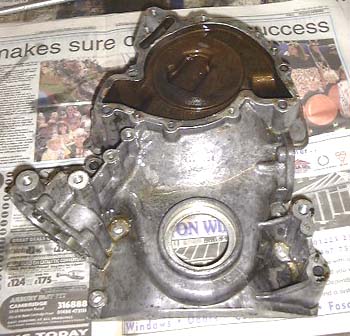 I ordered some more big end bearings from Real Steel.
I ordered some more big end bearings from Real Steel.
During the evening I cleaned up the timing cover rather more than I had managed originally. This is a fearsomely complicated casting which contains
- the front crankshaft seal
- the distributor mounting
- the oil pump
- the water pump mounting
and probably a bunch of other things too. At catalogue prices of between £150 and £450 it's worth the £75 I paid for the engine just for this.
Of course, all the nooks and crannies makes it difficult to clean but I'm getting there.
I also checked the oil pump gears and their mounting. I had bought some new gears from Real Steel but the housing needed a bit of clearing up before everything turned smoothly.
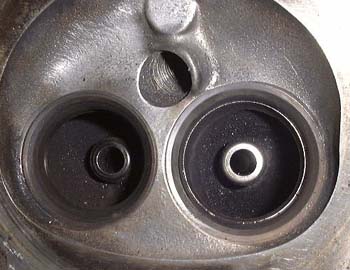 After that I looked at one of the cylinder heads. I took all the valves out of one and
cleaned up the chambers and had a look at the seats and ports. Everything looks fine really, although I'm a bit
concerned about how clear the oil ways are.
After that I looked at one of the cylinder heads. I took all the valves out of one and
cleaned up the chambers and had a look at the seats and ports. Everything looks fine really, although I'm a bit
concerned about how clear the oil ways are.
As for improving the flow rates of the head there are some obvious areas for improvement. The inlet valves look
shrouded, the ports are actually narrower than the valve seats just behind the seats themselves. The inlet and
exhaust ports look as though they could well be cleaned up very well, the exhaust ports in particular look tiny.
What I would like is to try and set up some way of measuring flow rate through the ports before setting about the
heads. It wouldn't have to be accurate, just be monotonically related to the real values of flow. I think I'll
peruse a few catalogues...
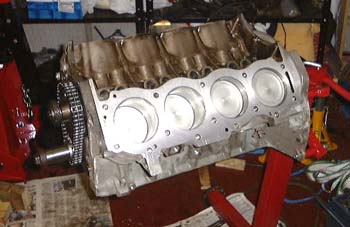 The new big end bearings had arrived from Real Steel, so I set about installing
the pistons again. Everything went together much better than last time, mainly as I realised that I had been putting
the big end bearing caps on the wrong way round. This time it's possible to turn the crank over easily, even though
the cam and timing gear are installed now. Dooohhh. In other words, it's a good job I had to take everything to
bits again.
The new big end bearings had arrived from Real Steel, so I set about installing
the pistons again. Everything went together much better than last time, mainly as I realised that I had been putting
the big end bearing caps on the wrong way round. This time it's possible to turn the crank over easily, even though
the cam and timing gear are installed now. Dooohhh. In other words, it's a good job I had to take everything to
bits again.
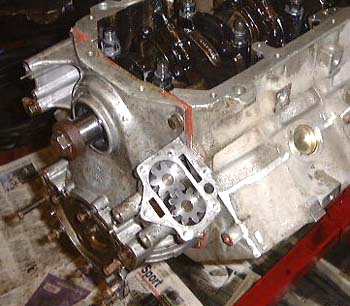 Next I installed the timing cover and put the oil pump back together again. There are two recommended
ways of priming the oil pump. One is to pack it with petroleum jelly, the other is to buy a tool that drives the
oil pump down the distributor hole with the benefit of an electric drill.
Next I installed the timing cover and put the oil pump back together again. There are two recommended
ways of priming the oil pump. One is to pack it with petroleum jelly, the other is to buy a tool that drives the
oil pump down the distributor hole with the benefit of an electric drill.
I've decided on a belt-and-braces approach so I packed it with Vaseline anyway, even though I've already got a drive tool. As I've got a lot of new bearings in this engine I would hate it to be turning over for real without decent oil pressure. When I get to firing it up I shall take this bit very carefully.
Before doing that I checked the oil pump gear clearance, as recommended in the Haynes manual. On mine, presumably as I bought some new gears, the clearance was at the unworn end of the range.
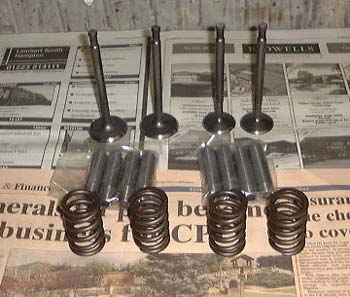 I made another trip to Real Steel today. Having decided to go my own way on
the heads I decided to replace the valves and guides. The existing ones are quite worn and if I should want to
fit a higher lift camshaft I would have to machine the guides down anyway. Real Steel do some guides that are shorter
and have tapered noses to allow better gas flow in the ports. Also, they've just started doing inlet guides that
are machined to take the later model inlet valve oil seals, which seems a good idea.
I made another trip to Real Steel today. Having decided to go my own way on
the heads I decided to replace the valves and guides. The existing ones are quite worn and if I should want to
fit a higher lift camshaft I would have to machine the guides down anyway. Real Steel do some guides that are shorter
and have tapered noses to allow better gas flow in the ports. Also, they've just started doing inlet guides that
are machined to take the later model inlet valve oil seals, which seems a good idea.
I now have to get the new guides fitted and get the seats cut for the new valves.
 Finally, in a weekend that included far too much real work, I put together one of the rocker
shafts with the new shafts and rockers and the original pedestals and springs. Working on the engine is much nicer
now as everything's clean, even shiny sometimes...
Finally, in a weekend that included far too much real work, I put together one of the rocker
shafts with the new shafts and rockers and the original pedestals and springs. Working on the engine is much nicer
now as everything's clean, even shiny sometimes...
Assembled the other rocker shaft and dismantled the other head. Interestingly the valves and guides seemed rather
less worn on this head, perhaps the oil flow is better? I now need to get the new guides installed somehow.
I've come to the conclusion that the best approach to any additional head work is just to open out the valve throats
to match the seats. (The inlet valves, for example, seem to be slightly blocked just behind the seat.) Also, opening
out the ports to match the inlet and exhaust manifolds and smoothing the path to them seems sensible.
in case you've got to this frame directly and can't get out, go here.